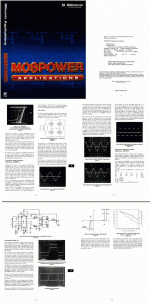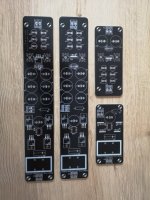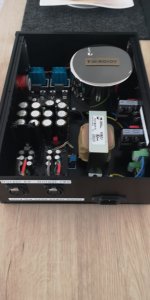There is recently a lot of noise about "IDEAL" MOSFET rectifiers using the LT4320 and the like.
So just out of curiosity, I did a bit of search on the internet.
Firstly the LT4320 is not the only product on the market.
TI has a solution based on the LM74670.
And even simpler is the PD70224, which has everything in a single package.
But is the idea of using MOSFET for rectification new ?
By no means.
Just see the many examples in references 1~5, dating back to 2006, i.e. more than 10 years.
What are the supposed benefits ?
Low voltage drop across the rectifier, and possibly lower ON resistance.
Or in other words, low power losses.
Do I really care in audio ?
Take a typical example of a Class A power amp with +/-16V rails, 4A per channel.
Using a full bridge rectifier, the total power loss in the rectifiers is ~16W.
The total power consumption of the amplifier itself is 128W.
And suppose we also use a regulator with 2.5V voltage drop per rail, that is an additional 20W.
Therefore, the power saving using a (unrealistically) no-loss rectifier is <10%.
And since I need heatsink for the amp and the regulator anyhow, 10% extra for the rectifier is no real issue.
Unless I ordered the wrong transformer and is running out of voltage headroom, what is the argument then ?
Are there any down side of using a MOSFET rectifier ?
I can come up with a few :
1. All chip based solutions have built-in charge pumps in the controller to switch on the MOSFETs.
Even if they operate at some 6MHz switching frequency, I am not sure whether I want a SMPS in my analogue circuit.
2. When using a discrete solution without a charge pump, they have many more components than 4 diodes.
More components mean more things to go wrong, and more reliability issues.
3. None of the MOSFET solutions at the same rating are lower costs than 4x power diodes.
Is there one reason why I would use MOSFET, other than trying something fancy ?
Perhaps, if it can be proven that they lead to less transformer ringing than a soft recovery diode.
But I am totally open minded. Just need to be convinced.
The floor is open for rational, technical arguments and discussions.
Cheers,
Patrick
So just out of curiosity, I did a bit of search on the internet.
Firstly the LT4320 is not the only product on the market.
TI has a solution based on the LM74670.
And even simpler is the PD70224, which has everything in a single package.
But is the idea of using MOSFET for rectification new ?
By no means.
Just see the many examples in references 1~5, dating back to 2006, i.e. more than 10 years.
What are the supposed benefits ?
Low voltage drop across the rectifier, and possibly lower ON resistance.
Or in other words, low power losses.
Do I really care in audio ?
Take a typical example of a Class A power amp with +/-16V rails, 4A per channel.
Using a full bridge rectifier, the total power loss in the rectifiers is ~16W.
The total power consumption of the amplifier itself is 128W.
And suppose we also use a regulator with 2.5V voltage drop per rail, that is an additional 20W.
Therefore, the power saving using a (unrealistically) no-loss rectifier is <10%.
And since I need heatsink for the amp and the regulator anyhow, 10% extra for the rectifier is no real issue.
Unless I ordered the wrong transformer and is running out of voltage headroom, what is the argument then ?
Are there any down side of using a MOSFET rectifier ?
I can come up with a few :
1. All chip based solutions have built-in charge pumps in the controller to switch on the MOSFETs.
Even if they operate at some 6MHz switching frequency, I am not sure whether I want a SMPS in my analogue circuit.
2. When using a discrete solution without a charge pump, they have many more components than 4 diodes.
More components mean more things to go wrong, and more reliability issues.
3. None of the MOSFET solutions at the same rating are lower costs than 4x power diodes.
Is there one reason why I would use MOSFET, other than trying something fancy ?
Perhaps, if it can be proven that they lead to less transformer ringing than a soft recovery diode.
But I am totally open minded. Just need to be convinced.
The floor is open for rational, technical arguments and discussions.
Cheers,
Patrick
References :
1. MOS-FET Rectifier (2006)
2. Active rectification - Wikipedia
3. https://pdfs.semanticscholar.org/9f6f/3e377a74eebe1f02a7a30d9678b745609f16.pdf (2013)
4. https://www.onsemi.com/pub/Collateral/NMLU1210-D.PDF
5. https://www.edn.com/design/componen...ETs-Increased-Efficiency-In-Bridge-Rectifiers (2007)
6. PD70224 https://www.microsemi.com/product-directory/poe-pd-front-end-w-pwm-controller/4787-pd70224
7. LT4320 https://www.analog.com/en/products/lt4320.html
8. lm74670 https://e2e.ti.com/blogs_/b/industr...approach-to-full-wave-bridge-rectifier-design
Patrick
1. MOS-FET Rectifier (2006)
2. Active rectification - Wikipedia
3. https://pdfs.semanticscholar.org/9f6f/3e377a74eebe1f02a7a30d9678b745609f16.pdf (2013)
4. https://www.onsemi.com/pub/Collateral/NMLU1210-D.PDF
5. https://www.edn.com/design/componen...ETs-Increased-Efficiency-In-Bridge-Rectifiers (2007)
6. PD70224 https://www.microsemi.com/product-directory/poe-pd-front-end-w-pwm-controller/4787-pd70224
7. LT4320 https://www.analog.com/en/products/lt4320.html
8. lm74670 https://e2e.ti.com/blogs_/b/industr...approach-to-full-wave-bridge-rectifier-design
Patrick
Add 30 years to your 10 years: I have been pioneering the technique of SyncRect in the late seventies, early eighties, and even then it made sense: for low-voltage, high current logic supplies.But is the idea of using MOSFET for rectification new ? By no means. Just see the many examples in references 1~5, dating back to 2006, i.e. more than 10 years.
At the time, I used BJT's, because it was the only realistic option available. The base was driven from a small auxiliary winding to minimize the losses. The resulting supply was moderately more complex than a regular one, but it outperformed vastly those based on "dumb" diodes.
Nowadays, all the common PC supplies use SyncRect at the secondary, and some begin to use it for the mains rectification: when you begin to exceed 95% efficiency, that is one of the last places where you can still scrape 0.5~1%.
Of course, when you already waste a few hundreds watts in a tube or class A amplifier (or both), it makes little sense to go that route.
Some discrete, DIY possibilities anyway: Synchronous Rectifier Controller filament supply using two bridges 6.3 filament from 5vac winding - Page 2 - diyAudio 6.3vdc form 6.3v ac PSU - Page 2 - diyAudio
It's only a matter of design choices, if you don't find the advantages convincing enough then it's not or you. Simple as that.
The cost effectiveness is an issue and power savings can be wavered away as a nice side effect, so nothing remains to be positive about.
Nonetheless, I substituted the old silicons in a few Jadis amplifiers and some other tube amps (filament supplies) because the old technology came physically loose because of the constant delta temps. I never had one broken down, the active circuit doesn't even need cooling and all customers claim it sounded way better.
The drawbacks of the LT are a minimum of 9 v DC and a maximum of 72, last one depends also on used Fet's of course. And it doesn't regulate above a few hundred Hertz, which leaves out rectification for switching supplies. It does make the whole circuit a lot smaller and not dependant on cooling, as well as makes many transistor amps spew out a few watts more. And of course it's more "green", if you like that color ;-)
You could also argue that a more direct connection to the transformer would be benificial regarding SQ, but imho depends on the fet's used.
There's some calculations done here:
The Frog - Technical data, calculations and considerations - Streaming Audio Solutions
Though for DIY, I think I overpriced it. It's been some years back, this was version 2 already..
The cost effectiveness is an issue and power savings can be wavered away as a nice side effect, so nothing remains to be positive about.
Nonetheless, I substituted the old silicons in a few Jadis amplifiers and some other tube amps (filament supplies) because the old technology came physically loose because of the constant delta temps. I never had one broken down, the active circuit doesn't even need cooling and all customers claim it sounded way better.
The drawbacks of the LT are a minimum of 9 v DC and a maximum of 72, last one depends also on used Fet's of course. And it doesn't regulate above a few hundred Hertz, which leaves out rectification for switching supplies. It does make the whole circuit a lot smaller and not dependant on cooling, as well as makes many transistor amps spew out a few watts more. And of course it's more "green", if you like that color ;-)
You could also argue that a more direct connection to the transformer would be benificial regarding SQ, but imho depends on the fet's used.
There's some calculations done here:
The Frog - Technical data, calculations and considerations - Streaming Audio Solutions
Though for DIY, I think I overpriced it. It's been some years back, this was version 2 already..
And of course it's more "green", if you like that color ;-)
With high power devices, the gain is quite certain. But with low power devices, the electricity saved isn't much. My gut feeling is that the savings wouldn't offset the extra work involved with those rectifiers (pcb, soldering, etc) compared to a good old diode bridge. I really wonder how to assess the break even point.
The ONLY reason i get interested in the sync rectification is the hope it may lead to less switching noise and thus better sound. Reports along these lines have so far been encouraging. Of course, for the strictly engineering types, audible differences alone may be of very little importance.
....is the idea of using MOSFET for rectification new?... dating back to 2006, i.e. more than 10 years. ....
First thing I thought of: the Siliconix MOSPOWER Applications book from 1984. Shows sync MOSFET rectification and benefits. Around page 5-91.
I doubt it was new then. It was probably done with Mercury tubes long ago, to reduce even the small ignition delay of Mercury.
Attachments
Hello, I have spent some time comparing different types of diodes and rectifiers in countless comparisons and different usage profiles according to sonic criteria. Surprisingly, diodes sound different. 4 years ago, I also included the mosfet rectifiers in the comparisons. to make it short, you could the respective tonal advantages of e.g vishay glass diodes, hexfred diodes and all rectifiers used for comparison. mosfet-rectification had in sum all positive sound properties of comparison group. Over the past 4 years, I've built well over 300 high quality power supplies with mosfet rectification. i used it in all power supplies for e.g. nuc, streamer, dac, pre-amp, etc. the tonal enhancement to conventional rectifiers is more than remarkable. I started with the standard circuit from the LT 4320 data sheet. meanwhile i have 4 own board layouts, for positive as well as negative power supply. I have universally applicable power supplies for analog and digital devices that dont need not fear the comparison with international power tools.
regards
regards
that dont need not fear the comparison with international power tools.
Better than Black&Decker?
Nice report, but where are the pics?
i love Google translate ;-)Better than Black&Decker?
Nice report, but where are the pics?
i got binford-tools in my mind

Attachments
- Status
- This old topic is closed. If you want to reopen this topic, contact a moderator using the "Report Post" button.
- Home
- Amplifiers
- Power Supplies
- "Ideal" MOSFET Rectifiers



